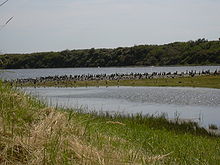Parc du Marquenterre
The Parc du Marquenterre is one of the most famous bird sanctuaries in France . It covers an area of 250 ha in the extreme northeast of the Somme Bay within the 3000 ha nature reserve Réserve naturelle de la Baie de Somme in the Somme estuary .
Administratively, the park, established in 1973, belongs to the Somme department .
Name etymology
The name Marquenterre is a compressed corruption of the sentence la mer qui rentre dans la terre (English: "The sea that comes back into the land"); this sentence characterizes the history of the estuary's origins: At high tide, heavy salt water penetrates upstream and flows under the fresh water of the Somme; this flood current brings in a lot of sand and silt, which cannot be completely removed by the weaker ebb current. The result is a partial silting up of the watercourse on the one hand and flooding of the land on the other hand as well as a mixing of fresh water and salt water.
From 1963 the resulting polders were first used for agriculture. In 1973 agriculture was stopped and the bird sanctuary was set up.
nature
The natural landscape is versatile and varied on a small area. The maintenance of this variability is moderately regulated by the park administration.
While the entrance area is surrounded by a slightly elevated, small pine forest area, the wide plain of the estuary extends below a lookout point, which is characterized by shallow pools, reed beds and salt marshes . Brackish water areas with 8-25 g salt / liter spread along the coastal dam , connected to fresh water channels. The park administration regulates the salinity of the water through locks; some bird species need more fresh water in winter than in summer.
Poplars and willows line the freshwater canals. A regulated cut 4 m above the ground encourages the pasture to knock out new shoots.
In the dunes and on the dry sandy soils, there is a rich flora with rockrose , sea buckthorn , common heather and dune rose . 265 plant species have been counted on the area since the park was set up in 1973 to 2007.
Bird species
Between the establishment of the park and 2007, 344 species have been documented. Numerous migratory birds find their winter quarters here; other bird species remain in the Somme Bay for most of the year.
In spring, the white stork , gray heron and the spoonbill from the Netherlands seek their breeding grounds in the small wooded area of the upper park area. Avocets , oystercatchers and lapwing nest in the marsh meadows and on sandy islands in the middle of the shallow pools . In the lagoon behind a sand dune, small wading birds appear on the way to Siberia, where they breed in summer; at high tide many are sandpipers , stilt walkers and egrets in large numbers to be found in search of fish food.
From the end of summer onwards, greylag goose and numerous species of ducks remain in the park throughout the winter . Large colonies of wigeon , teal , teal, and mallard appear in late autumn; Cormorants populate some sand islands all year round. With the first frost come the sawsman , the white-fronted goose , the coot , and the grebes ; Colorful Russian pintail and shelduck are among the species rarely found in Central Europe outside the park, the godwit is on the red list of threatened species.
Tourist infrastructure
The park entrance with information center can be approached by car from Rue and Le Crotoy ; there are large parking spaces in the forest. Within the site, it is only possible to move on foot along three marked routes - which can be combined with one another - on a total of 6 km of route, which can be walked individually or as part of organized group tours with explanations.
13 wooden huts have been set up as observation posts along the way. Binoculars are required to identify the animals. Documentation boards explain the bird species in each station, depending on the season.
All three paths end at a breeding ground for the rare little egret , which is unique in France in this form. In spring they breed in colonies on trees; the young birds fledge in summer. In August you can still find a few stragglers, in autumn and winter the colony is deserted. The rearing is regulated and promoted by the park administration in a protected outdoor enclosure.
Attached to the information center are a restaurant and a sales point for literature and regional agricultural products. a. from sea buckthorn and apples.
literature
- Sonia Lesot (text), Henri Gaud (photos): Le Marquenterre en Baie de Somme. Une réserve naturelle et un parc ornithologique entre terre et mer . Éditions Gaud, Moisenay-le-Petit 2006, ISBN 978-2-840-80150-4 .
Web links
- Location on the Baie de Somme
- official page
- Tourist information
- Series of pictures of the park landscape and the water birds
Coordinates: 50 ° 14 ′ 45 ″ N , 1 ° 33 ′ 4 ″ E


